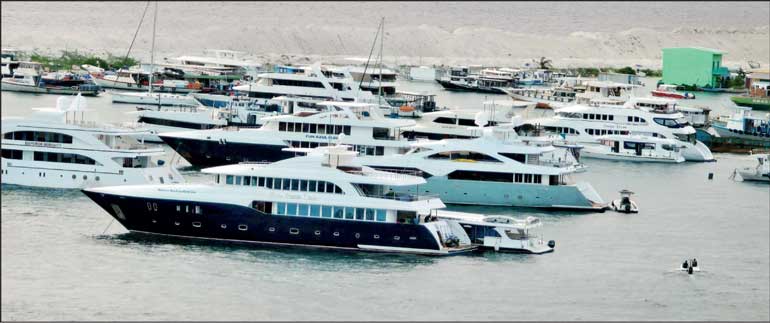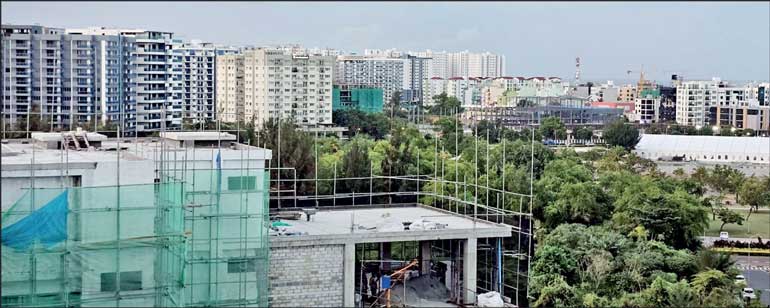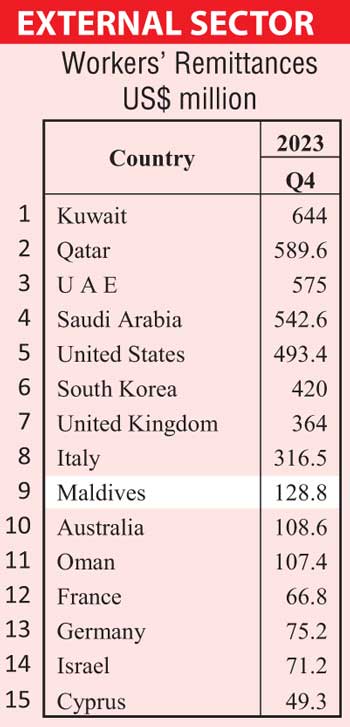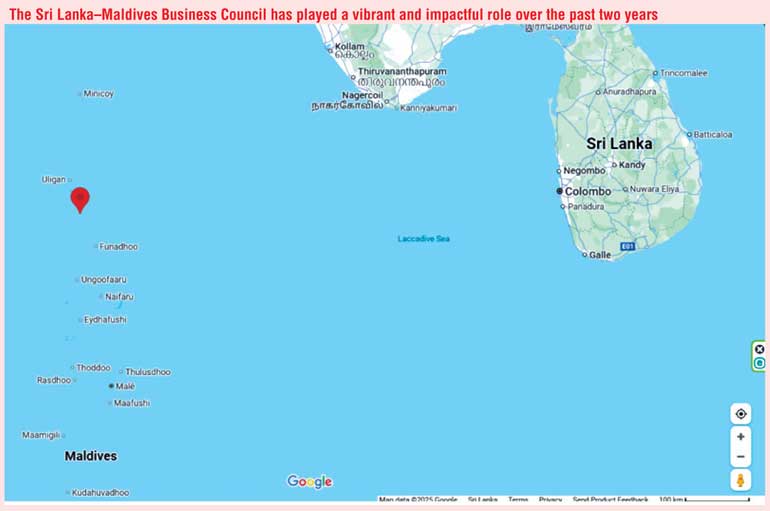Sunday Dec 14, 2025
Sunday Dec 14, 2025
Monday, 28 July 2025 01:26 - - {{hitsCtrl.values.hits}}

Luxury safari boats – each boat has 6 to 12 rooms (floating hotels)
Hulhumalé Phase 1, Maldives

King Mahaabarana Adeettiya (Koimala) was the first ruler to govern the entire Maldives from 1117 to 1141 (24 years). Before him, earlier rulers only controlled specific parts of the Maldives or what was known as Deeva Maari (and Dheeva Mahal) at that time.
Koimala is believed to be a Sinhalese prince of royal lineage from Ceylon. Legend has it that he married the daughter of the king of Ceylon and embarked on a journey with her in two vessels. Upon reaching the Maldives, they encountered calm seas and decided to rest in Northern Maalhosmadulhu Atoll. The king and his entourage settled at Rasgetheemu Island (meaning the King’s Island), while the queen and her servants stayed at Angolhitheem Island (meaning the Queen’s Island or island of servants) in the same atoll.
At that time, the Maldivian islanders were followers of Buddhism. Learning that the two distinguished visitors were of royal descent from the Buddhist kingdom of Ceylon, they extended an invitation for them to stay. Eventually, Koimala was proclaimed their king at Rasgetheemu. The newly crowned king and his spouse migrated to Malé, settling there with the approval of the indigenous people of Giraavaru, the most significant community in Malé Atoll. Before Koimala’s reign, the Maldives is believed to have been governed by various matriarchies across different atolls.
The Mahāvaṃsa (300 BCE) documents individuals from Sri Lanka relocating to the Maldives. Considering the origin of cowrie shells in the Maldives, historians speculate that inhabitants might have existed in the Maldives during the Indus Valley civilisation (3300–1300 BCE). Various artefacts provide evidence of the coexistence of Buddhism and Hinduism in the Maldives before the Islamic era.
The Maldives’ earliest recorded history begins with the arrival of Sinhalese people, descended from the exiled Magadha Prince Vijaya from the ancient city of Sinhapura in Northeast India. Around 543 to 483 BC, Vijaya and his group, numbering several hundred, landed not only in Sri Lanka but also in the Maldives. This account is detailed in the Mahavansa.
 Following King Koimala, King Dhovemi (later known as Sultan Muhammad al-Adil) ruled from 1141 to 1165 for a span of 24 years. (This means both kings were originally from Sri Lanka). Initially a Buddhist until 1153, he was the son of Henevi Maava Kilege, brother of Koimala, and a member of the Soma or Homa (Lunar) dynasty. In 1153, he embraced Islam, assumed the title Sultan, and established the Theemuge dynasty. Known as the Benevolent King or Dharumavantha Radun, his reign left a lasting impact. It was during his rule that the entire country embraced Islam, marking a significant transformation in Maldivian history.
Following King Koimala, King Dhovemi (later known as Sultan Muhammad al-Adil) ruled from 1141 to 1165 for a span of 24 years. (This means both kings were originally from Sri Lanka). Initially a Buddhist until 1153, he was the son of Henevi Maava Kilege, brother of Koimala, and a member of the Soma or Homa (Lunar) dynasty. In 1153, he embraced Islam, assumed the title Sultan, and established the Theemuge dynasty. Known as the Benevolent King or Dharumavantha Radun, his reign left a lasting impact. It was during his rule that the entire country embraced Islam, marking a significant transformation in Maldivian history.
In the past, the Maldivian National Hospital bore the name of King Dharumavantha, a name that distinctly carries a Sinhala origin. Archaeological evidence in the Maldives primarily consists of Buddhist stupas and monasteries, with artefacts displaying unmistakable Buddhist iconography. Additionally, linguistic similarities between the Maldivian language and Sinhala words hint at a historical connection, suggesting a shared heritage with Sri Lanka and a Buddhist influence, even though the Maldives is currently a Muslim country. Archaeological inscriptions found in the Maldives are nearly identical to those found in Sri Lanka.
This clearly shows that the Maldivian civilisation has strong roots connected to Sri Lanka. If that were not true, the Maldivian people would not have accepted Sinhalese kings as their rulers.
About Maldives
The Maldives is considered one of the safest countries in Asia, with no record of any shooting incidents in recent years. The only major security incident occurred on 3 November 1988, when Sri Lankan LTTE fighters arrived by sea and attacked key locations in Malé, the capital. This act was carried out by a foreign group, not by Maldivians.
Additionally, the Maldives is one of the few countries where sparkling candles, firecrackers, and sky rockets are completely banned. As a result, the country maintains a very low crime rate compared to other nations in the region
Maldives market share
The 2023 market share in Maldives in imports has slightly increase to 4.6%, but in 2024 it has reduced to 3.72. Achieving less than a 4% market share is disappointing for us.
Example the UAE, a country that manufactures very little domestically, holds a 15% market share in the Maldives. We must seriously question how they have achieved this and why we have not. The answer lies in several factors: the absence of heavy taxes, the free zone concept, business-friendly regulations, and lower freight rates. These are areas where we need to improve if we are to compete effectively.
How many Maldivians live in Sri Lanka
In 2018, there were 17,000 Maldivians living in Sri Lanka. Now, that number has dropped to only 1,700.
Estimated loss would be minimum $ 59.2 million per year. This can be even 200 million per year.
The Maldives offers nearly 100 scholarships annually to Maldivian students to study abroad. This presents a valuable opportunity for Sri Lanka to tap into and develop the education tourism sector.
In addition, the Aasandha Scheme, the national health insurance program, covers all Maldivian citizens. Under this scheme, Maldivians are eligible to travel abroad for medical treatment, with expenses fully covered by the government. This creates a significant opportunity for developing medical tourism in Sri Lanka.
The main reason for this decline was the visa issue. Following the Easter Sunday attacks, Sri Lanka led to stricter visa regulations and restrictions. This situation created significant obstacles for Maldivians seeking to travel to Sri Lanka.




As a result, India capitalised on this opportunity by developing Trivandrum as a preferred destination for Maldivians. They established hospitals and other essential facilities tailored to the needs of Maldivian citizens, aligning them with their national insurance schemes. This strategic move effectively redirected a significant portion of our business to India.
Trade agreement
It is unfortunate that there is still no proper trade agreement between our two countries. Last year, Turkey signed a trade agreement with the Maldives, clearly demonstrating the growing interest of other nations in this small but significant market. As a result of the lack of such an agreement, Sri Lankan boat exports to Malé have declined due to a 40% import tax, while exporters from countries with trade agreements enjoy a reduced tax rate of just 10%.
How many Sri Lankans work In Maldives?
Currently, there are about 30,000 workers in the Maldives who have obtained work permits, along with an additional 2,500 family members residing there, bringing the total to 32,500 people. Of this number, 755 are students studying in the Maldives.
Workers remittance
According to the Central Bank report, worker remittances from the Maldives contribute approximately $ 129 million per year to Sri Lanka. However, if we consider a conservative estimate where a minimum monthly salary is $ 500 per person, and assume 30,000 Sri Lankans are employed in the Maldives, the total potential annual remittance should be around $ 180 million ($ 500 × 30,000 × 12 months).
The actual remittance figure is significantly lower because over 60% of workers do not remit money through formal banking channels. This is mainly due to high bank charges and the wide gap between the buying and selling exchange rates. For example, if someone sends $ 500 through a bank, they lose approximately Rs. 9,500 due to conversion rates and fees. For $ 1,000, the loss can be around Rs. 22,000.
As a result, many workers choose informal methods to send money. Based on these factors—and considering that some individuals earn as much as $ 15,000 per month—we estimate the actual remittance from the Maldives to Sri Lanka could range between $ 230 to 275 million per year.
Maldives developments
Hulhumalé Phase 1, Maldives
It is a reclaimed island, with land reclamation work starting in 1997 and completed in 2002. The official inauguration took place in 2004. Since then, the island has seen rapid development, including the construction of hotels, residential flats, luxury apartments, schools, mosques, roads, parks, and hospitals. Over the past 21 years, the transformation has been truly remarkable — especially considering that the island did not even exist before.
Today, Maldives is no longer the same country it was 20 years ago. Its GDP per capita stands at $ 12,530—clearly indicating the country’s purchasing power and potential.
Opportunities
Introducing ferry services between Maldivians and Sri Lankans engaged in business between the two countries. This initiative could significantly boost the tourism industry.
Introducing wooden boat serves – currently, most of the fruits, vegetables, live animals aggregate and fertilisers that the Maldives receives from India are transported by wooden boats.
Sri Lankan companies to invest in Maldivian agriculture if they invest, they also can do other business such as boat building, etc.
Furthermore, the Kulhudhuffushi port in northern Maldives is seeking investors for joint development, with several opportunities for establishing warehouses and related facilities.
A special port in the northern Maldives, located closer to Colombo, has offered attractive conditions, including a 50% tax discount for small boat operations. This initiative aims to reduce freight costs and other related charges. However, if this port is handed over to India, it could pose a significant challenge to Sri Lanka’s Galle Port.
Sri Lanka-Maldives Business Council’s impactful role
The Sri Lanka-Maldives Business Council has played a vibrant and impactful role over the past two years, maintaining Sri Lanka’s market presence in the Maldives and promoting Maldivian engagement with Sri Lanka.
With the support of the Export Development Board (EDB), the Council successfully organised a trade exhibition in the Maldives, offering a 50% discount to exhibitors. Additionally, the Council facilitated discounted hotel accommodations, reduced airfare, and free logistics support for all participants.
To further strengthen bilateral ties, especially in education and healthcare, the Council planned another event this year — the Education and Wellness Expo — to promote Sri Lankan universities, hospitals, and wellness centres to the Maldivian public.
In January this year, the Council also carried out a meaningful CSR initiative in Faresmaathodaa Island, located 445 km from Malé. During this project, they donated 600 spectacles and essential medical equipment to island residents — a gesture that went viral across Maldivian media.
Thanks to the continuous efforts of the Council and the Sri Lankan Embassy in Malé, several longstanding issues have been resolved, paving the way for stronger collaboration. With the recent appointment of a new Government in Sri Lanka, we are hopeful and ready to write a new chapter in Sri Lanka-Maldives relations.
All eyes are now on the upcoming visit of the President of Sri Lanka to the Maldives — a highly anticipated event, with many eager to see the outcomes and opportunities it will bring for both nations.
(The writer is the President of the Sri Lanka Maldives Business Council.)